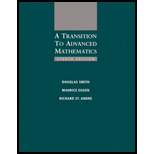
Concept explainers
(a) Let a be a negative real number. Prove that if a is a solution to the equation
(b) Let x be a real number. Prove that
(c) Let a and b be positive integers such that
(d) Prove that if x is a real number and
(e) Prove that no point inside the circle
(f) Let x be a real number. Prove that if
(g) Suppose that x is a real number. Prove that
(h) Prove that if two nonvertical lines are perpendicular, then the product of their slopes is -1. (Recall that nonvertical lines are those lines in the plane that have slope.)
(i) Prove that there exists a point
(j) Prove that there is a pair, and only one pair,
Trending nowThis is a popular solution!

Chapter 1 Solutions
A Transition to Advanced Mathematics
- 2. Consider the ODE u' = ƒ (u) = u² + r where r is a parameter that can take the values r = −1, −0.5, -0.1, 0.1. For each value of r: (a) Sketch ƒ(u) = u² + r and determine the equilibrium points. (b) Draw the phase line. (d) Determine the stability of the equilibrium points. (d) Plot the direction field and some sample solutions,i.e., u(t) (e) Describe how location of the equilibrium points and their stability change as you increase the parameter r. (f) Using the matlab program phaseline.m generate a solution for each value of r and the initial condition u(0) = 0.9. Print and turn in your result for r = −1. Do not forget to add a figure caption. (g) In the matlab program phaseline.m set the initial condition to u(0) = 1.1 and simulate the ode over the time interval t = [0, 10] for different values of r. What happens? Why? You do not need to turn in a plot for (g), just describe what happens.arrow_forwardTrue or False and whyarrow_forward10 5 Obtain by multiplying matrices the composite coordinate transformation of two transformations, first x' = (x + y√√2+2)/2 y' = z' (x√√2-2√2)/2 z = (-x+y√√2-2)/2 followed by x" = (x'√√2+z'√√2)/2 y" = (-x'y'√√2+2')/2 z" = (x'y'√√2-2')/2.arrow_forward
- Not use ai pleasearrow_forward4 The plane 2x+3y+ 6z = 6 intersects the coordinate axes at P, Q, and R, forming a triangle. Draw a figure and identify the three points on it. Also find vectors PQ and PR. Write a vector formula for the area of the triangle PQR and find its value.arrow_forwardAND B A Ꭰarrow_forward
- I just need b,c,darrow_forward8. In the following check to see if the set S is a vector subspace of the corresponding Rn. If it is not, explain why not. If it is, then find a basis and the dimension. X1 (a) S = X2 {[2], n ≤ n } c X1 X2 CR² X1 (b) S X2 = X3 X4 x1 + x2 x3 = 0arrow_forward5 Obtain by multiplying matrices the composite coordinate transformation of two transformations, first x' = (x + y√2+ z)/2 followed by y' = (x√√2-2√2)/2 z' = (-x+y√2-2)/2 x" = y" 2" = (x'√√2+2'√√2)/2 (-x'y'√√2+)/2 (x'y' √√2-z)/2.arrow_forward
 College Algebra (MindTap Course List)AlgebraISBN:9781305652231Author:R. David Gustafson, Jeff HughesPublisher:Cengage Learning
College Algebra (MindTap Course List)AlgebraISBN:9781305652231Author:R. David Gustafson, Jeff HughesPublisher:Cengage Learning Algebra for College StudentsAlgebraISBN:9781285195780Author:Jerome E. Kaufmann, Karen L. SchwittersPublisher:Cengage LearningAlgebra & Trigonometry with Analytic GeometryAlgebraISBN:9781133382119Author:SwokowskiPublisher:Cengage
Algebra for College StudentsAlgebraISBN:9781285195780Author:Jerome E. Kaufmann, Karen L. SchwittersPublisher:Cengage LearningAlgebra & Trigonometry with Analytic GeometryAlgebraISBN:9781133382119Author:SwokowskiPublisher:Cengage Algebra: Structure And Method, Book 1AlgebraISBN:9780395977224Author:Richard G. Brown, Mary P. Dolciani, Robert H. Sorgenfrey, William L. ColePublisher:McDougal Littell
Algebra: Structure And Method, Book 1AlgebraISBN:9780395977224Author:Richard G. Brown, Mary P. Dolciani, Robert H. Sorgenfrey, William L. ColePublisher:McDougal Littell



